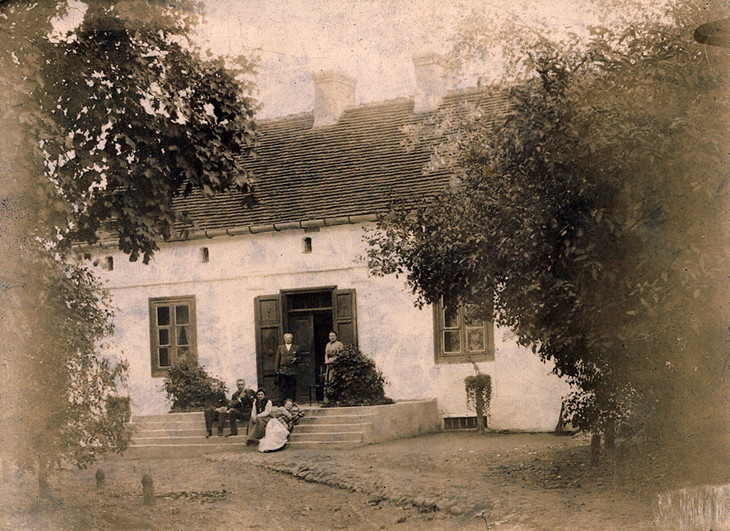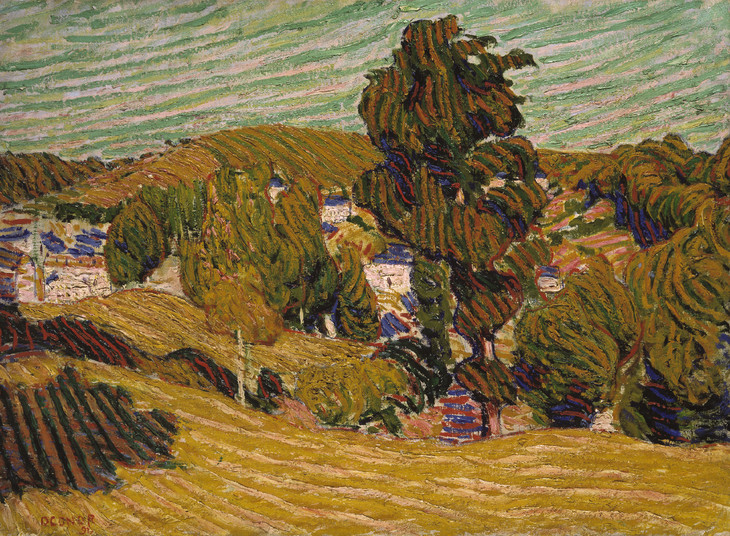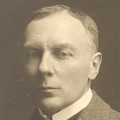Robert Bevan Morning over the Ploughed Fields c.1904
Robert Bevan,
Morning over the Ploughed Fields
c.1904
Bevan painted this work in Poland where he often stayed with the family of his wife, Stanislawa de Karlowska. Vague blue trees dot a horizon line set back into the distance under morning sky daubed with pink. The use of strong colour, lack of figurative detail and fluid brushstrokes reflect his study of post-impressionism.
Robert Bevan 1865–1925
Morning over the Ploughed Fields
c.1904
Oil paint on canvas mounted on hardboard
222 x 278 mm
Purchased 1969
T01121
c.1904
Oil paint on canvas mounted on hardboard
222 x 278 mm
Purchased 1969
T01121
Ownership history
Inherited by Stanislawa de Karlowksa (1876–1952), the artist’s wife; given in the 1920s to their son, Robert Alexander Bevan (1901–1974), by whom sold to D’Offay Couper Gallery, London, before or in 1969, where purchased by Tate Gallery 1969.
Exhibition history
1969
Robert Bevan: Early Paintings 1895–1908, D’Offay Couper Gallery, London, April–May 1969 (8, reproduced).
Technique and condition
Morning over the Ploughed Fields is painted in artists’ oil paints on canvas applied on board. The canvas appears to be plain weave linen and has been prepared with white priming. Pin holes and semi-circular marks in the paint in the top corners of the canvas suggest it was pinned to a board, with drawing pins, while the paint layers were still drying. There is no indication that the canvas was ever stretched after painting, the canvas appears to have been cut to its present size and stuck directly down onto the smooth face of a 4mm thick hardboard panel. The ‘Bevan’ studio stamp has been applied on the back of the hardboard (see also Tate N05911).
The painting has the immediacy and freshness of a sketch executed in situ. The rectangular shape within which the main part of the image is painted is roughly sketched in pencil onto the primed canvas prior to painting. There is no other preliminary drawing underlying the landscape. The rich, fluid paint was applied rapidly in predominantly horizontal strokes using a relatively large brush for the small size of the canvas. In many areas, such as the foreground, the priming is left visible between the brushstrokes. The paint retains the texture of the brush with its delicate peaked impastos that enhance the sense of light and texture in the sketch. The bright colours are sometimes intermixed on the canvas where they were applied wet-in-wet.
A soft resin varnish was applied, which collected in the hollows of the paint texture and now has a slight yellow colour. There is no varnish on the board or edges of the canvas, indicating that it was possibly applied before the canvas was cut and marouflaged (see also Tate N04750).
Roy Perry
December 2003
How to cite
Roy Perry, 'Technique and Condition', December 2003, in Robert Upstone, ‘Morning over the Ploughed Fields c.1904 by Robert Bevan’, catalogue entry, May 2009, in Helena Bonett, Ysanne Holt, Jennifer Mundy (eds.), The Camden Town Group in Context, Tate Research Publication, May 2012, https://wwwEntry
In July 1897 Bevan attended the wedding in Jersey of his friend Eric Forbes-Robertson (1865–1935). Forbes-Robertson was marrying Janina Flamm, a Polish art student who had attended the Académie Julian. Her bridesmaid was Stanislawa de Karlowska, another student at Julian’s, although she and Janina attended the school after Bevan had left. Bevan immediately fell in love with Karlowska. It is apparent that he must have made his feelings known while they were still in Jersey for, after she had returned home to her native Poland, on 25 July Bevan wrote the first of a series of passionate letters he sent to her that summer.1 Neither spoke the other’s language and so the correspondence courtship was conducted in French. On 24 September Bevan wrote to her that he was starting for Paris, and from there he would travel onwards to her father’s estate at Szeliwy, near Lowicz in Central Poland, then under Russian control. It was a long journey, and Bevan only ‘found his way with some difficulty’;2 but by October or early November Bevan appears to have arrived. By 12 November, when Bevan’s mother wrote to congratulate Karlowska, the couple was engaged, and they were married in Warsaw on 9 December 1897.3

The Karlowski family estate at Szeliwy, near Lowicz in Russian-occupied Poland c.1897/1899 from left to right: unknown man, Robert Bevan, Stanislawa de Karlowska, Stanislawa's father Aleksander Prawdzic-Karlowski, Stanislawa's sisters Halina and Julia
Courtesy of Patrick Baty
Fig.1
The Karlowski family estate at Szeliwy, near Lowicz in Russian-occupied Poland c.1897/1899 from left to right: unknown man, Robert Bevan, Stanislawa de Karlowska, Stanislawa's father Aleksander Prawdzic-Karlowski, Stanislawa's sisters Halina and Julia
Courtesy of Patrick Baty
Karlowska’s family at Szeliwy was described by the Bevans’ son as ‘squirearchs’:
They had substantial estates, but they were not absentee landlords; they farmed the land themselves. They bred horses and cattle for themselves and for sale; they had their own water-mills, their own small forests and sawmills. They ate their own meat, poultry and game ... There was not very much flow of cash. My mother’s family lived in what was then Russian territory, but social life was entirely apart from the Russians. Polish landlords were, however, always subject to sudden police raids, especially when a family had a history of patriotic activity. My mother’s father ... endangered his life and suffered considerable financial loss through the part he played in the Polish rebellion of 1863.4
The couple settled in England, living first with Bevan’s parents at Horsgate in Sussex and then moving to Brighton and then in 1900 to London. Bevan went on painting trips in Poland staying with Karlowska’s family in 1899, 1901, 1903, 1904, 1907, 1909 and 1910 (fig.1). ‘During these years,’ their son wrote,
Bevan developed a strong feeling for Poland and the Poles. But the life in Poland which Bevan shared with his wife’s family was a country kind of life he had not previously known intimately ... One can say that Poland wakened in my father a very intense affection, a romantic sympathy that is reflected in much of his work of these early years. He was never happier than when he was working in Poland and living among Poles.5
On these visits Bevan filled seven sketchbooks, now in the Ashmolean Museum, Oxford,6 and made independent crayon drawings. He also made a number of oil sketches painted directly in the open air, of which Morning over the Ploughed Fields is an example. Painted loosely, using fluid strokes of the brush, this is likely to show land on Karlowska’s family estate. Nearly empty of almost all meaningful detail, there is an almost Whistlerian sparseness to the design, but the bold colour scheme is entirely the product of Bevan’s study of impressionism. There is a similarity in the banding of colours to the landscapes made at Pont-Aven by the Irish painter Roderic O’Conor, who was there at the same time as Bevan and whom he is likely to have met. But O’Conor’s landscapes, such as Tate’s Yellow Landscape 1892 (Tate T02113, fig.2) from this time, were usually painted in a slightly harder edged, more rigidly defined style. Bevan’s more liquid handling has more affinity with the work of impressionists such as Claude Monet or Alfred Sisley. Blue trees mark the horizon, while an area of yellow at the left centre indicates a barn. The pink clouds indicate that this is a dawn scene. Along the horizon there are ridges of paint where the brush has hesitated, to create a deliberate rhythm. There is a visible pencil border around the canvas, as if it is bigger than the framed area.

Roderic O'Conor 1860–1940
Yellow Landscape 1892
Oil on canvas
support: 676 x 918 mm; frame: 930 x 1168 x 105 mm
Tate T02113
Presented by Mr and Mrs Barnett Shine through the Friends of the Tate Gallery 1977
Fig.2
Roderic O'Conor
Yellow Landscape 1892
Tate T02113
Robert A. Bevan, the artist’s son, believed that Morning over the Ploughed Fields must date from either his father’s 1901 or 1903 Polish trip, but that ‘stylistically it seems more likely to be 1901’.7 A similar landscape study entitled The Purple Field, Poland (private collection)8 is dated to this year, although the manner of execution is more formal. Robert A. Bevan’s rationale for dating the Polish pictures is the age of the child in The Gate at Szeliwy (private collection),9 which depicts Karlowska holding the hand of their daughter Edith born in 1898. The adventurous palette of Morning over the Ploughed Fields is highly unusual and advanced. None of the Fauves were using such strong colouring at such an early date, although O’Conor and other artists at Pont-Aven were. The rationale for this chronology, however, could potentially be flawed; one possibility is that the child in The Gate at Szeliwy is not Edith Bevan but Robert Alexander Bevan himself, wearing a knee-length dress of the type common to Edwardian male children. He was born in 1901, and this would date The Gate at Szeliwy to 1904–5 if the child depicted was around three years old. This is a far more acceptable date on stylistic grounds and would apparently come from the visit to Poland of that year. Another alternative is that it is a different child altogether.
During the early years of the new century Bevan’s style varied quite markedly and he seems to have been experimenting or searching for a consistent approach. This is evident in the pictures deriving from his visits to Poland; in Polish Landscape 1901 (private collection)10 he adopts short, distinct brushstrokes which recall the work of Monet or Pissarro. In The Courtyard of 1904 (private collection)11 he returns to a rich, sensuous version of synthetism reminiscent of Gauguin or, more closely, his friend Eric Forbes-Robertson; while in The Smithy at Szeliwy No.2 c.1906–7 (private collection)12 he adopted a divisionist technique.
In 1905 at the age of forty, Bevan held his first solo exhibition, at the small and not particularly prestigious Baillie Gallery in Bayswater. The show consisted entirely of Polish paintings and drawings, although Morning over the Ploughed Fields was not shown. The reception was disappointing, with most of the small number of press reviews being negative. The Glasgow Herald wrote of Bevan somewhat disparagingly that ‘compared to some of his works in oil where he seems to reconcile violent greens, yellows and reds ... even the most Monetesque of Monets must appear reticent’.13 The bright colours of The Courtyard were dubbed ‘garish’ by Black and White, which complained the picture had ‘an evil habit of losing control over itself’.14 But the more prestigious Studio had a favourable response and six months later reproduced two of Bevan’s watercolours, one as a colour plate.15 ‘I think the years of loneliness and neglect’, Robert A. Bevan wrote, ‘had their effect on my father’s temperament. They made him more shy, more reserved, more reluctant to fight the battle of selling. But they did not destroy his courage or his power of working out problems for himself.’16
Robert Upstone
May 2009
Notes
Related biographies
How to cite
Robert Upstone, ‘Morning over the Ploughed Fields c.1904 by Robert Bevan’, catalogue entry, May 2009, in Helena Bonett, Ysanne Holt, Jennifer Mundy (eds.), The Camden Town Group in Context, Tate Research Publication, May 2012, https://www



